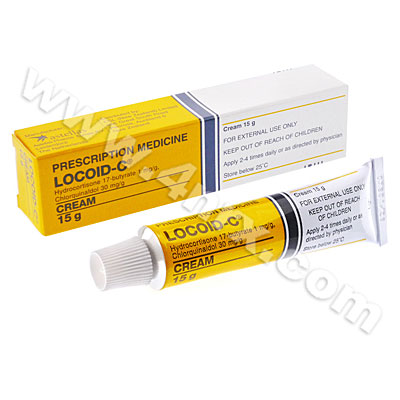 |
Home  Skin Skin  Locoid C Cream (Hydrocortisone Butyrate) Locoid C Cream (Hydrocortisone Butyrate) |
|
|||||||||
|
Locoid C Cream (Hydrocortisone Butyrate)
What is Locoid C Cream (Hydrocortisone Butyrate) used for? Locoid C Cream (Hydrocortisone Butyrate) is a topical treatment effective in relieving the swelling, itchiness and redness caused by skin conditions such as dermatitis, eczema and psoriasis, and also skin conditions which are complicated by bacterial or fungal infections. It contains two active ingredients. Hydrocortisone is a corticosteroid, which helps to relieve swelling and itchiness, and chlorquinaldol is an antimicrobial, which fights fungi and bacteria. How should I use Locoid C Cream (Hydrocortisone Butyrate)? If you have been prescribed Locoid C Cream (Hydrocortisone Butyrate) to treat a skin condition, follow the instructions provided to you by your physician. This cream is usually applied 2 to 4 times per day. Ensure that the affected area, as well as your hands, are clean and dry before you apply it. Only use this cream for the period of time for which it was prescribed by your physician. You should inform your physician if your condition worsens or persists after 2 weeks of treatment. What are the side effects of Locoid C Cream (Hydrocortisone Butyrate)? Some possible side effects which may occur as a result of applying Locoid C Cream (Hydrocortisone Butyrate) to the skin include:
You should immediately inform your physician if you notice any side effects when using this cream. Please Note Strictly follow all instructions provided to you by your physician or pharmacist while using Locoid C Cream (Hydrocortisone Butyrate). Optimum and safe dosage can differ based on the patient and the condition being treated. As this medication may be unsafe for certain patients, it is essential you always inform your physician if you are pregnant or breastfeeding, as well as if you have any allergies, other illnesses, or ongoing health conditions, and if you are taking any other form of medication, supplements, or herbal products. Immediately seek emergency medical care if you have any allergic or hypersensitive reaction. Common signs of a reaction include hives, swelling, skin rashes, chest pains, as well as trouble breathing or swallowing. 
|
|||||||||||||||||